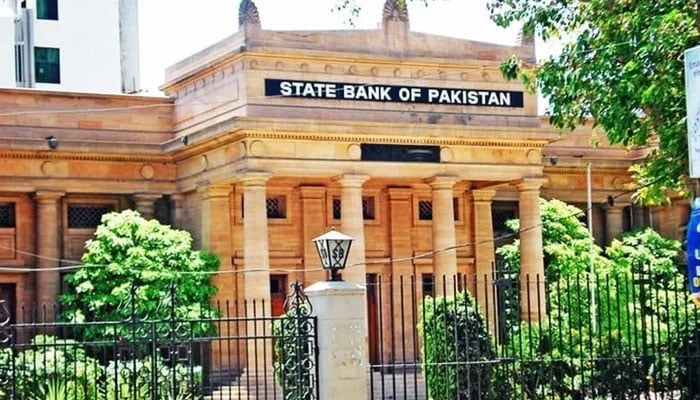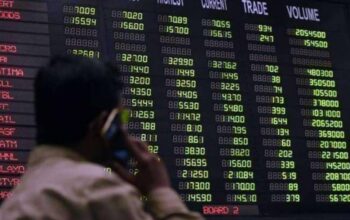By Staff Reporter
KARACHI: The central bank is expected to keep its policy rate unchanged on Monday as escalating tensions between Israel and Iran stoke fears of rising commodity prices, threatening a resurgence of inflation in the financially strained country
The State Bank of Pakistan (SBP) will likely hold its benchmark rate at 12%, according to 11 of 14 respondents in a snap poll conducted after Israel’s military strike on Iran on Friday. The attack, which Israel called a “preemptive strike” targeting nuclear facilities, ballistic missile factories, and military commanders, has shifted analyst expectations away from an anticipated rate cut.
Two respondents forecast a 100 basis-point reduction, while one predicted a 50 basis-point cut.
Pakistan condemned Israel’s actions as “unjustified and illegitimate aggression” against Iran, underscoring the geopolitical stakes. The hostilities have driven a sharp rebound in international crude oil prices to $68-70 a barrel, a critical concern for Pakistan, which depends heavily on imported energy. A prolonged conflict could tighten global crude supplies, amplifying imported inflation pressures.
“There remains an upside risk of a rise in global commodity prices in light of geopolitical tensions, which could mark a return to inflationary pressures,” said Ahmad Mobeen, senior economist at S&P Global Market Intelligence. “The resultant higher import bill could also threaten external sector performance and bring pressure to the exchange rate.”
Inflation’s Uneven Decline
Inflation has been trending lower after peaking at around 40% in May 2023, but last month it climbed to 3.5%, exceeding the finance ministry’s projection of up to 2%. The uptick, driven partly by fading base effects, has raised concerns about price stability. The SBP projects average inflation of 5.5% to 7.5% for the fiscal year ending June.
The central bank paused its easing cycle in March after cutting rates by a cumulative 1,000 basis points from a record high of 22%. It resumed with a 100 basis-point reduction in May. Monday’s decision follows a tight annual budget that boosted defense spending by 20% while trimming overall expenditure by 7%, with GDP growth forecast at 4.2%.
The government credits a $7 billion International Monetary Fund bailout with stabilizing the $410 billion economy and averting a default. Yet, some analysts doubt the 4.2% growth target is achievable amid fiscal constraints and external vulnerabilities.
Abdul Azeem, head of research at Al Habib Capital Markets, argued for a 50 basis-point cut, saying it could “support the GDP target of 4.2% and reduce the debt financing burden.”
Market Sentiment Pivots
Several brokerages had expected a rate cut but reversed course after the Israeli strikes heightened fears of a broader Middle East conflict. A Topline Securities poll found 56% of market participants now anticipate the SBP will maintain the status quo, up from 31% in a prior survey. Of the 44% expecting a cut, 19% predict a 50 basis-point reduction, and 25% see a 100 basis-point drop.
“In our view, the central bank has further room for around a 100-basis-point cut as we expect FY26 inflation to average between 6-7%, translating into a real rate of 400-500 basis points,” Topline Securities said in a statement. “However, we expect status quo in the upcoming monetary policy.”
The brokerage highlighted rising oil prices, spurred by Middle East tensions and an anticipated US-China trade deal, as a reason for caution. “This warrants a cautious approach from policymakers, as oil price movements have remained a major driver of inflation in the past,” it added.
Looming Price Pressures
Additional inflationary risks loom, with gas and electricity price notifications expected before the next fiscal year begins. “The inflationary impact of these measures is yet to be assessed and absorbed, in our view,” Topline Securities noted. “That said, we believe the central bank will observe status quo in the upcoming meeting.”
Market signals reflect the cautious mood. Since the last policy meeting on May 5, when eight of nine monetary policy committee members voted for a 100 basis-point cut, yields on six-month KIBOR and Treasury bills have fallen 88-99 basis points to 11.09% and 10.95%, respectively.
Longer-Term Outlook
Looking ahead to December 2025, a Topline Research poll of key market participants reveals evolving expectations. Regarding the policy rate, 42% of respondents now predict it will fall to 8-10%, up from 37% in a previous survey, while 58% expect it to stay above 10%, down from 63%, signaling cautious optimism about further easing.
On inflation, 69% of participants forecast an average of 6-8% for FY26, with 20% expecting 8-10% and 11% anticipating below 6%; Topline’s projection of 6-7% aligns closely with the government’s 7.5% target and the IMF’s 7.7% estimate.
As for the currency, 36% of respondents see the rupee weakening beyond 290 per US dollar by December 2025, up from 26% previously, while 64% expect it to range between 280-290, with market consensus pointing to 288-292 by year-end and 298-302 by June 2026. Topline Research projects the interest rate will bottom out at 10% by December 2025.
“We expect the interest rate to fall to and bottom out at 10% by December 2025,” Topline said.
Copyright © 2021 Independent Pakistan | All rights reserved




